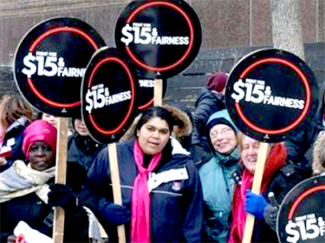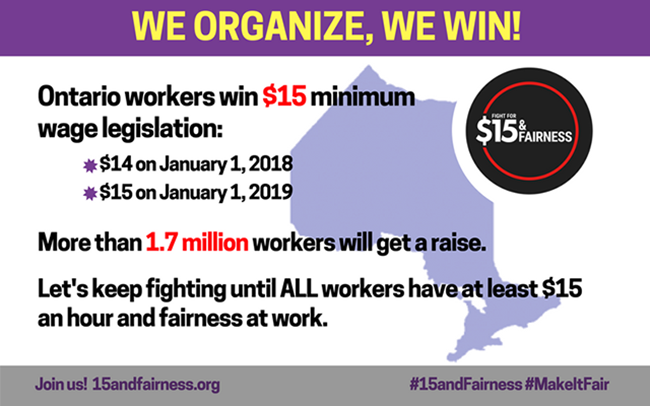TEAM 15
Ontario workers win $15 min. wage doing it their way

CALL IT A REVERSE ROLLING STONE MOMENT. Workers in Ontario won’t get all they need. But they will get a lot of what they want: beginning with a $15 an hour minimum wage—something most workers in North America can still only dream of.
A big, big win: remarkable on its own, but even more remarkable because of how it was done.
The $15 and Fairness campaign was built from the street up. Its success was built on the self-reliance and spontaneity of its supporters. There was no set script to follow—just a desire to win a $15 an hour minimum wage. In the end that’s what made all the difference.
Realistic but bold
In 2013, community and union groups—including the Workers’ Action Centre in Toronto and the Ontario Federation of Labour—launched the Campaign to Raise the Minimum Wage to $14 an hour. It failed. But it did get the newly elected Liberal government to promise a review of provincial employment and labor laws.
In January 2015, the Liberals did create the Changing Workplaces Review—with the explicit directive that raising the minimum wage would not be on the agenda. Many others had other plans.
Leading the way were the low-wage, nonunionized workers organized by the Workers’ Action Centre in Toronto. These workers spent several months developing a list of demands they thought would be realistic enough to achieve but bold enough to inspire. The drive for a raise in the minimum wage was relaunched in April 2015 as the Fight for $15 and Fairness.
The campaign set out to unite union and nonunion workers and to use the Changing Workplaces Review as a province-wide setting in which to advance their cause. From the outset, the activists were clear that simply lobbying politicians for legislative changes would never produce the concrete gains they wanted and needed.
The Fight for $15 and Fairness campaign got solid support from many unions. The Ontario Federation of Labour joined in with its own Make It Fair campaign. But it was continuous worker energy and commitment that the campaign counted on most—and it worked.
Local roots, provincial coordination
Activists used centrally produced materials such as leaflets, petitions, and buttons, but each chapter was free to determine its own activity level—often in coordination with other chapters.
Activists came together in small groups in colleges, workplaces and in other communities where they were already rooted. For instance, workers and students in the healthcare sector mobilized the Decent Work and Health Network to build public pressure for paid sick days and to end employer requirements for doctors’ notes.
Activists in the faith community used the $15 and Fairness demands to craft a statement framing the struggle as a moral issue.
The campaign built an extensive network of campus groups that united union and nonunion workers, faculty, and students. In one instance this support included a student boycott of Aramark food services in support of striking members of Unite Here Local 75 at York University and the University of Toronto.
The strikers won big, with a $15 starting wage and massively improved benefits.

More like a jazz group than an army
The mass outreach strategy did not have unanimous support to start with. A number of labour leaders argued for a more traditional approach that would work within the framework of the Liberal government’s Changing Workplaces Review travelling hearings.
The ultimate success of the mass outreach strategy proved how workers can trust in themselves to imagine, create and apply their own ways to win.
Although highly localized the overall campaign always stayed on target and coordinated: they did this with province-wide teleconferences, in-person strategy sessions and a province-wide campus assembly in September 2017.
One commentator noted: “Some now say winning a $15 minimum wage in Ontario was inevitable. But it only became that way because people organized like hell to make it so.
“The campaign did not rely on rigid discipline. Rather, it resembled the free-flowing creative collaboration of a jazz group.”
No doubt the Liberal late-November activation of Bill 148: Fair Workplaces Better Jobs Act is crass political opportunism on their part. But, that fact only demonstrates the importance of the $15 and Fairness campaign: it was precisely the mass appeal of the campaign that made it so that no political party in Ontario dare directly oppose its core demands.
Lessons learned
There are three key reasons for the success of the Ontario $15 & Fairness campaign—namely:
- picking goals that inspire, but are still realistically within reach
- creating a big tent that welcomes all comers
- building up, and building on, trust in one another to achieve our best.
The campaign centered its efforts on workers and their experiences to create a broad class appeal. This raised expectations, allowing activists to build a united front of unionized and nonunionized workers, community and student groups.
The campaign focused on mobilizing workers province-wide to engage in mass outreach to other workers. It used a rolling barrage of methods to achieve this end: protesting, petitioning, lobbying, postering, writing to newspapers, holding public events, releasing videos, dropping banners, phone banking, door knocking, and even striking.
The campaign attracted and held on to skilled, intellectually curious, and compassionate people. This, in turn, lead to a campaign culture that cared about the people involved in it as much as winning, that aimed to build people up, and gave workers the chance to shape the movement in a way that reflected their own experiences and communities.
There could be no better guide on how to build winning campaigns in our future.
- 30 -











Add new comment